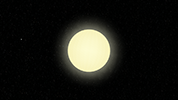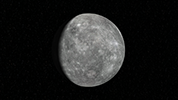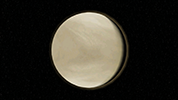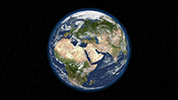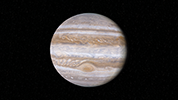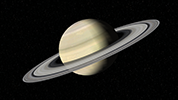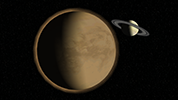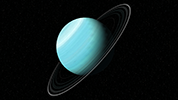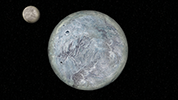SOL SYSTEM
SOL SYSTEM
v1.1
Version History
v1.0 Initial Release
v1.1 Update
(see read me.txt)
v1.0 Initial Release
v1.1 Update
(see read me.txt)
The Sol system (or Solar system or Terran system) is a star system located in Sector 001, in the Alpha Quadrant. Sol (also: "The Sun" or "Helios") is the common name for the star that formed the Sol system, where the planet Earth is located. It is a main sequence star of the spectral class G2 with an age of approximately 4.5 billion years and will at least shine for another 5 billion years.
Mercury (or Sol I) is the first planet in the Sol system and is named after the Roman god Mercury, envoy of the gods according to Terran mythology. Having only a minimal atmosphere and orbiting Sol at a distance of just 0.39 Astronomical units, temperatures on the Mercurian surface range from 100 to 700 Kelvin.
Venus (or Sol II) is the second planet in the Sol system named after the Roman goddess of love in Earth mythology, Venus. Orbiting Sol at a distance of 0.72 astronomical units and having a dense carbon dioxide atmosphere creating a pressure of 95 bars on her surface, Venus suffers from a runaway greenhouse effect resulting in temperatures of up to 763 Kelvin. In addition, the Venusian atmosphere contains high concentrations of sulfuric acid.
The third planet of the Sol system is Earth, homeworld of the humanity and capitol of the United Federation of Planets. The planet Earth was formed approximately 4.5 billion years ago, during the formation of the Sol system. Earth is classified as a Class M world, although Earth's classification borders on Pelagic (Class O), as two-thirds of the planet's surface is liquid water. There are several major landmasses and a wide variety of climatic and surface conditions, ranging from tundra to desert. The vast majority of the land surface is temperate or semi-temperate. Earth was one of the founding members of the Federation in 2161. Earth became one of the Federation's most important worlds, so much so that some Klingons claim that the Federation is known throughout the galaxy as a "Homo Sapiens-only club".
Mars is approximately half the size of Earth, and only one-tenth the mass. The planet's characteristic red hue is due to large amounts of iron oxide (rust), having twice as much in its outer layer as Earth. It is a cold and dry world, with many amazing geological formations. The extinct shield volcano Olympus Mons (Mount Olympus) stands in a vast uplift region called Tharsis (which contains several large volcanos) and at 27 km tall is the tallest mountain in the Sol system. Utopia Planitia is a vast lava plain on the planet Mars, and location of the surface structures of the starship construction facility, the Utopia Planitia Fleet Yards, one of the Federation's most extensive construction yards. It is partly positioned in synchronous orbit 16 kilometers above the Utopia Planitia region on Mars.
Jupiter is the fifth planet of the Sol System. It has the most moons of any planet in the Sol system with 63 known moons. The major moons are Io, Starfleet maintain a research facility on this moon, Europa, Ganymede and Callisto. Although Jupiter itself is uninhabited, itself and its moons are Federation territory.
Saturn is the sixth planet of the Sol System. The number of known moons orbiting Saturn has been a constantly changing figure during space exploration. The most notable include Janus, Mimas, Titan, and Hyperion.
Uranus is the seventh planet from Sol in the Sol system. Also like Saturn, Uranus has an plantary ring.
Neptune is the eighth planet from Sol, in the Sol system.
Pluto is the ninth and outermost planet of the Sol system, circling Sol at a distance of 39.5 astronomical units. It is the smallest planet in the system, with an equatorial diameter of 2274 kilometers and, together with its companion Charon, forms a double planet system.
Mercury (or Sol I) is the first planet in the Sol system and is named after the Roman god Mercury, envoy of the gods according to Terran mythology. Having only a minimal atmosphere and orbiting Sol at a distance of just 0.39 Astronomical units, temperatures on the Mercurian surface range from 100 to 700 Kelvin.
Venus (or Sol II) is the second planet in the Sol system named after the Roman goddess of love in Earth mythology, Venus. Orbiting Sol at a distance of 0.72 astronomical units and having a dense carbon dioxide atmosphere creating a pressure of 95 bars on her surface, Venus suffers from a runaway greenhouse effect resulting in temperatures of up to 763 Kelvin. In addition, the Venusian atmosphere contains high concentrations of sulfuric acid.
The third planet of the Sol system is Earth, homeworld of the humanity and capitol of the United Federation of Planets. The planet Earth was formed approximately 4.5 billion years ago, during the formation of the Sol system. Earth is classified as a Class M world, although Earth's classification borders on Pelagic (Class O), as two-thirds of the planet's surface is liquid water. There are several major landmasses and a wide variety of climatic and surface conditions, ranging from tundra to desert. The vast majority of the land surface is temperate or semi-temperate. Earth was one of the founding members of the Federation in 2161. Earth became one of the Federation's most important worlds, so much so that some Klingons claim that the Federation is known throughout the galaxy as a "Homo Sapiens-only club".
Mars is approximately half the size of Earth, and only one-tenth the mass. The planet's characteristic red hue is due to large amounts of iron oxide (rust), having twice as much in its outer layer as Earth. It is a cold and dry world, with many amazing geological formations. The extinct shield volcano Olympus Mons (Mount Olympus) stands in a vast uplift region called Tharsis (which contains several large volcanos) and at 27 km tall is the tallest mountain in the Sol system. Utopia Planitia is a vast lava plain on the planet Mars, and location of the surface structures of the starship construction facility, the Utopia Planitia Fleet Yards, one of the Federation's most extensive construction yards. It is partly positioned in synchronous orbit 16 kilometers above the Utopia Planitia region on Mars.
Jupiter is the fifth planet of the Sol System. It has the most moons of any planet in the Sol system with 63 known moons. The major moons are Io, Starfleet maintain a research facility on this moon, Europa, Ganymede and Callisto. Although Jupiter itself is uninhabited, itself and its moons are Federation territory.
Saturn is the sixth planet of the Sol System. The number of known moons orbiting Saturn has been a constantly changing figure during space exploration. The most notable include Janus, Mimas, Titan, and Hyperion.
Uranus is the seventh planet from Sol in the Sol system. Also like Saturn, Uranus has an plantary ring.
Neptune is the eighth planet from Sol, in the Sol system.
Pluto is the ninth and outermost planet of the Sol system, circling Sol at a distance of 39.5 astronomical units. It is the smallest planet in the system, with an equatorial diameter of 2274 kilometers and, together with its companion Charon, forms a double planet system.
Last Revision: 05. Jan 2019
File Size: 12.5 Megabyte
